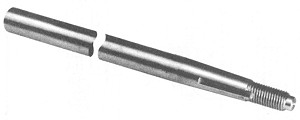The "best" shaft material depends on a number of different variables. These include whether the boat will be exclusively used in fresh water or be operated in brackish or salt waters. If intended solely for fresh water use, corrosion problems should not be a major issue. As such, the propeller shaft will, most likely, be less expensive. However, salt water can cause a range of corrosion problems, making the task of selecting an appropriate shaft material more crucial.
Basically, shaft materials are typically made of a variety of stainless steels or copper bearing materials. The copper bearing metals commonly used for propeller shafting are Monel alloys, Naval brass, and a variety of bronzes. Naval brass has a content of approximately 60 percent copper, while bronze must have a copper content of 90 percent or more; this makes it more superior.
Stainless Steel Shaft

Typically, the stainless steels used to make propeller shafts include types 630, 316, 304, and 303. All of them are strong, particularly the 630 variety. When used in salt water, stainless steel shaft is vulnerable to pitting which often results in crevice corrosion. When it comes to crevice corrosion, types 303 and 304 are widely viewed as the worst.
Type 316 is a lot less vulnerable and as such, it is much better suited for use in salt water. At this point in technology, the 630 type is perhaps right up there with the K-500 Monel competing for the top spot as the "best shaft material." Type 630 is priced higher than the other kinds of stainless steel materials. It is also stronger and is less susceptible to corrosion.
Stainless steel shaft has particular requirements for usage and installation that should be followed for the duration of its lifespan. For example, the sacrificial galvanic anodes are supposed to be positioned on or adjacent to the propeller shafts in brackish or salt waters, when the hull stays in the water. If the shafts are outfitted with anode collars, these could cause the shafts to become out of balance.
In addition, these types of anodes are more susceptible to erosion than those not located on the shaft. Careful attention should be paid to locating these anode collars so the flow of water to the propeller will not be restricted. For boats that have an elongated shaft tube that traps water beside the stainless steel propeller shaft, there must be a way to foster a positive water flow circulation to escape the corrosive impact of stagnant water when it makes contact with the stainless steel. All underwater equipment and electrical equipment must be grounded properly to a negative ground plate underwater. On trailerable boats, these issues are not a major concern.
Propeller Depot's expert machine shop is able to meet all of your inboard prop stainless shafting needs.










































